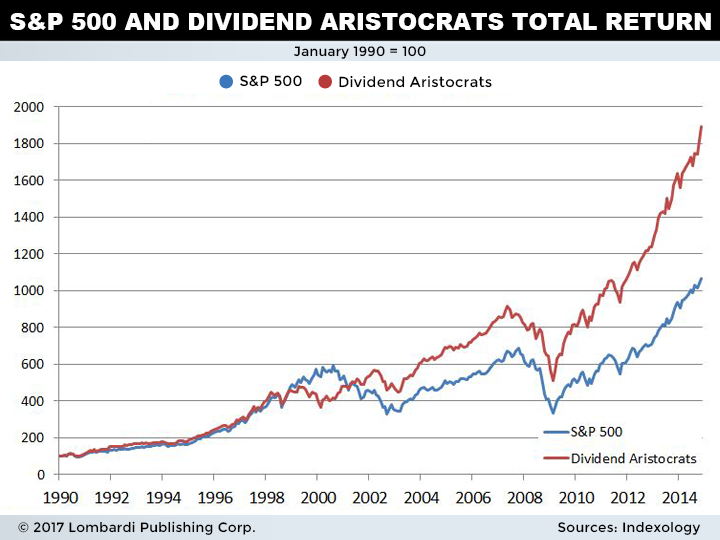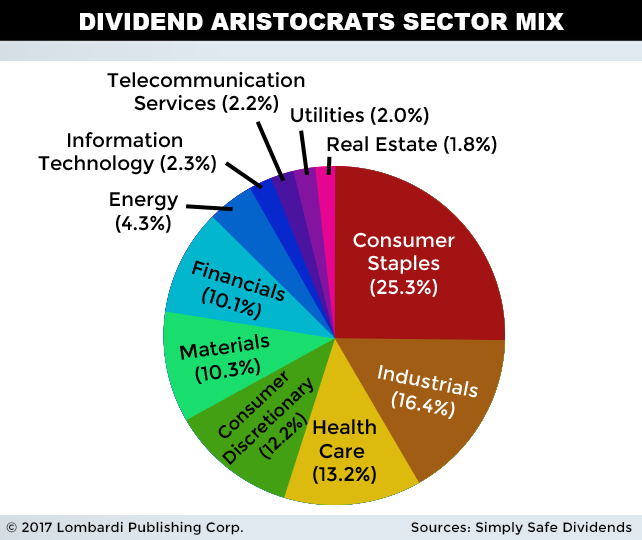Dividend Aristocrats Definition: What Are Dividend Aristocrats?

What is a Dividend Aristocrat?
This article will focus solely on “dividend aristocrat” stocks. These unique stocks and their exclusive index are notable for the regular increase in their dividend and for being well-known, large-cap, blue-chip companies.
However, these “dividend aristocrats” are also dividend growth stocks with a strong track record of a growing payout. This, and more, is detailed below, including how many dividend stocks are part of the index, the criteria to be part of the index, and how the index has performed compared to a broad-based one.
Dividend Aristocrat Definition
For a company to be considered a dividend aristocrat, it must be a U.S.-based member of the Fortune 500. These businesses must also have paid out a dividend for at least 25 consecutive years. However, not all companies that meet these criteria receive this title.
Those that make up the index are notable blue-chip businesses that offer large-cap stocks, thanks to these companies being well established in their market. They also enjoy stable and reliable earnings and revenue, hence the current and expected future dividend growth.
Importance of the Dividend Aristocrat List
The companies classified as dividend aristocrats have their own index: the S&P 500 Dividend Aristocrats Index. There is no set number of stocks that must be part of the index.
There is an administrative team that looks after the index and determines if a company should be removed or added to the index. Their goal is to have 10 sectors represented by the companies that make up the index. The team also considers the fundamentals of these businesses, with a combination of both value and growth stocks. Value stocks are those that are trading at a discount compared to their peers, while growth stocks would be expected to generate a higher rate of return than the market, possibly trading at a premium.
If a company’s dividend has been cut or goes a year without any changes, the index administrators immediately remove it. A company may also be removed if it is subject to an acquisition and no longer trading on the markets. However, if the business that acquires it happens to meet the criteria of the index, that company may be added itself.
When a company is removed from the index, another in the same sector is added in its place. This assures that all sectors continue to have representation.
Comparison of S&P 500 and S&P 500 Dividend Aristocrats Indices
The S&P 500 Index is compromised of the largest companies based in the United States. Many investors opt to look at these companies, since they are familiar and have a history of growing their businesses. Also, while the companies are based in the U.S., they have a presence around the world and are well-known brands. Also keep in mind that the S&P 500 Index is often used as a benchmark index, and is used for comparisons to a specific investment strategy or stock portfolio.
Stocks that are part of the S&P 500 Dividend Aristocrats Index could also be found in the S&P 500 Index. However, the Dividend Aristocrats Index only contains companies that have a history of growing their dividends.
Looking at how each of these indices have performed, there is no comparison. Below is a graph showcasing the results.

The S&P 500 Dividend Aristocrats Index has almost doubled the return of the S&P 500 Index. For the first 10 years of the graph above, there is no real difference in terms of the return. However, after the 10th year, the S&P 500 Dividend Aristocrats Index started to outperform. Why is this?
Well, the S&P 500 Index includes both stocks that pay a dividend and ones that do not. And some of the dividend stocks could face the possibility of the dividend being cut or halted. This affects the overall return, namely its income portion, since fewer investors would be interested in the company.
For the businesses in the S&P 500, those that do not pay a dividend are considered growth companies. These organizations could generate a higher return than the overall market, but the earnings and revenue are more volatile then those of a dividend company. This may result in generating a large amount of revenue, but an inability to maintain it. This, again, negatively impacts the returns from the S&P 500.
In contrast, the stocks in the S&P 500 Dividend Aristocrats Index continue to see their dividend grow, which means a greater return based on income. This also increases the average yield on the initial purchase price. The way this works is that a stock is purchased at a certain price and, as the dividend continues to grow, the average yield increases as well.
The dividend increasing also supports the idea of the share price rising. After all, investors who want income are going to look to companies that have a track record of growing their payouts. These companies also have more financially disciplined management teams, ensuring that a portion of their earnings will remain in a bank account to be paid out as dividends.
Another reason for the outperformance is that many of the stocks within the S&P 500 Dividend Aristocrats Index are protected from inflation. This means that business costs, while slightly higher, are passed along to the end customer. In addition, there is a lower chance of seeing huge swings in earnings and revenue due to the company’s continued growth.
Sectors in Dividend Aristocrats List
As mentioned earlier, there are 10 different sectors represented in the S&P 500 Dividend Aristocrats Index, with the top three being consumer staples, industrials, and healthcare. Below is a chart representing all 10 sectors and the percentage that each one accounts for.

Consumer staples companies are those that see their earnings and revenue grow no matter how the economy is performing. These businesses sell goods such as food, beverages, and healthcare products. Companies that would be considered consumer staples include PepsiCo, Inc. (NYSE:PEP), The Coca-Cola Co (NYSE:KO), and Procter & Gamble Co (NYSE:PG).
Industrials account for approximately 16% of all dividend aristocrats. These are businesses engaged in construction and manufacturing. This part of the index features companies such as 3M Co (NYSE:MMM), Illinois Tool Works Inc. (NYSE:ITW), and Stanley Black & Decker, Inc. (NYSE:SWK).
The healthcare sector consists of companies that have a large presence around the world and steady, reliable earnings and revenue. These healthcare stocks are not high-risk ones that are relying on a breakthrough drug, but rather the likes of Johnson & Johnson (NYSE:JNJ), Abbott Laboratories (NYSE:ABT), and Cardinal Health Inc (NYSE:CAH).
How Many Dividend Aristocrats Stocks Are There?
The S&P 500 Dividend Aristocrats Index normally contains between 50 and 54 stocks, with changes possible at any time. During the recession in 2009, the index fell to only 42 stocks because so many companies failed to grow.
The decision to add a company is not based solely on its dividend history and Fortune 500 status. Earnings trends and revenue patterns are also relevant.
How You Could Invest in S&P 500 Dividend Aristocrat Stocks
If you want exposure to the stocks that make up the S&P 500 Dividend Aristocrats Index, there are a couple of ways to do so.
1. Purchasing the Individual Stocks
One way of purchasing stocks would be via a broker. Simply log into a brokerage and purchase the shares. Each time a stock is purchased, it will incur a commission.
If you happen to have a investment advisor that manages your portfolio, they can handle the purchase.
Another option is contacting the broker that the company uses and purchasing the shares more directly. However, this broker can only purchase the shares for that one company–Johnson & Johnson’s broker can only deal with JNJ shares, for instance–so, while you save on commission costs, it can be time-consuming if you plan on purchasing a few different companies.
2. Exchange-Traded Funds
Rather than buying a few stocks for your investment portfolio, you can easily purchase all of them using an exchange-traded fund (ETF). ETFs are considered a pool of securities combined in a single product. They trade off the exchanges and can be purchased like a stock in the same way as if it was bought individually.
The ETF could be an exact duplicate of the holdings in the index and would represent the same percentage holdings of the index. Also, an advantage of this method is that only one commission would have to be paid, rather than multiple commissions; one for each stock that is purchased. This also adds to the diversification, since there would be more than 50 companies held with one ETF.
3. Mutual Funds
Mutual funds are similar to ETFs, providing access to all the stocks within the index. The difference is that there may be no need to pay commission with a mutual fund. They tend to require a minimum capital investment and holding period.
Another difference from an ETF is that a mutual fund tends to be priced at the end of the day, after the market is closed. This takes into account changes in the prices of securities within the index.
Final Thoughts About Dividend Aristocrat Stocks
Even though dividend aristocrats are great for an investment portfolio due to their stellar returns and strong growth histories, I would still recommend doing your research on potential stocks, ETFs, and/or mutual funds before making any investment.
Also ensure that the risk is appropriate for your comfort level. Lastly, consider how an investment in dividend aristocrat stocks is going to work in relation with your investment goals. After all, this is a strategy that benefits investors over the long term.











